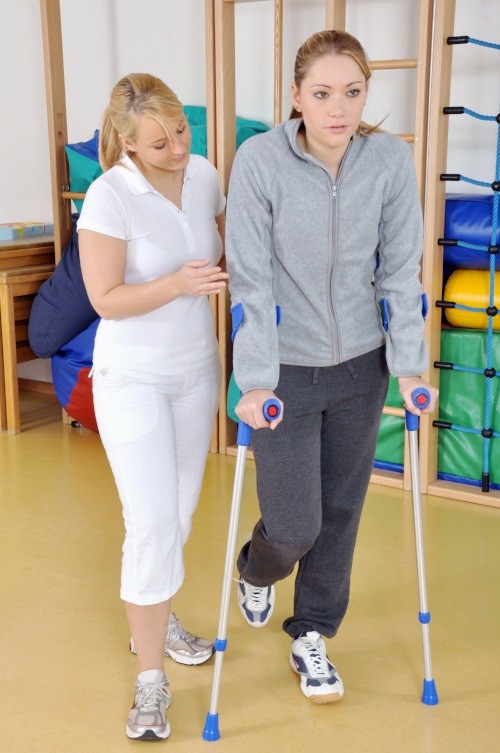
Ankle Sprain Treatments
Ankle Sprain Treatments
We’ve all been there.
You’ve made one awkward step and OUCH, you’ve twisted your ankle! In some cases you can shake it off without injury, while other times you’re reduced to hobbling around on one foot, or even worse.
Though some ankle sprains are sports related, others happen when you’re walking down the stairs, getting out of your car or simply getting out of a chair too quickly. Ankle sprains are a ligament injury and can be incredibly painful. Some injuries take up to 4-6 weeks to heal and others may require surgery. Treating an ankle sprain properly is important for the short and long-term effects of any ankle injury.
This month, Beaver Valley Foot Clinic’s Dr. Christina Teimouri shares her insight and expert advice on the variations of a sprain, how to treat them and how to prevent them from happening again.
Grades of Ankle Sprains
Grade 1. This is a mild sprain where ligaments slightly stretch. The ankle is a bit sore and a small amount of swelling may be present.
Grade 2. This is a moderate sprain where the ligaments are partially torn making the ankle joint feel loose. Putting weight on the ankle may be painful and the ankle will remain swollen for quite some time.
Grade 3. This is the most severe sprain because the ligament is completely torn. The injury to the joint is very painful and a large amount of swelling is present. The ankle will feel wobbly and a bit detached. It’s highly unlikely you’ll be able to put any sort of weight on your ankle.
How Can I Treat My Ankle Sprain?
Treatment will depend on the grade of the sprain and may require further direction from a podiatrist.
If you’ve suffered a sprain, he or she will likely tell you to follow the R.I.C.E. Method.
Rest. As with any injury or illness, rest is best. Keep off your ankle and put as little weight on it as possible.
Ice. For the first 48 hours, wrap the ankle with a bag of ice in a towel or a cold compress. After Day 3, space this out to every 3-4 hours for 20 minutes.
Compress. If your doctor places you in an elastic bandage or air-cast, be sure to follow their instructions and do not remove until they say so.
Elevate. Take a seat and keep your leg elevated as much as you can. Elevation reduces swelling as will taking Ibuprofen or other non-steroidal anti-inflammatory drugs (NSAIDs) which will also help with the pain.
Ankle Sprain Prevention
Accidents do happen and while you’ll never prevent all ankle sprains, there are several measures you can take to avoid this painful injury.
It’s All About the Shoes. Buying a good pair of shoes is important and they should be tied securely when worn. If you play sports, be sure to buy high-tops or whatever shoe your trainer, coach or PE Teacher suggests. And while most woman love high-heeled shoes, it’s worth noting most ankle sprains are a result of wearing them.
Stretch. Always stretch and warm up prior to physical activity, especially if you’ve experienced injury in the past.
Beware of Uneven Surfaces. Whether you’ve taken to the trails or you’re walking in the city, pay attention to what’s below you. Watch your step for rocks or uneven and cracked surfaces.
- Build Up Ankle Strength. Building up ankle strength is a great preventative technique. This can be done with single leg strengthening exercises like squats, lunges, dips and rubber band strengthening workouts. A stronger base will make it easier to stay on your feet and control change in body position.
Tape your Ankle. If you’ve already suffered an injury, it’s a good idea to tape your ankle to give it that extra bit of support it needs.
If you’ve ever experienced an ankle sprain you already know they are NO fun! You know your body best, if it doesn’t feel right it probably isn’t.
Are there risk factors that make someone more prone to ankle sprains?
Yes, several risk factors can make someone more prone to ankle sprains. These include:
- Previous Ankle Sprains: Individuals who have experienced ankle sprains in the past may be more susceptible to future sprains, especially if the previous injuries were not fully rehabilitated.
- Improper Footwear: Wearing inappropriate or ill-fitting shoes with inadequate ankle support increases the risk of ankle sprains.
- Participation in Sports: Athletes involved in sports that require sudden changes in direction, jumping, or quick stops are at a higher risk of ankle sprains. This includes sports like basketball, soccer, and volleyball.
- Anatomical Factors: Certain anatomical factors, such as high arches or a history of foot and ankle problems, can contribute to an increased risk of ankle sprains.
Are there situations where surgical intervention is necessary for ankle sprains?
In general, most ankle sprains can be successfully treated with conservative measures such as rest, ice, compression, elevation (R.I.C.E.), physical therapy, and sometimes bracing. However, in certain situations, surgical intervention may be considered for ankle sprains. These situations may include:
- Severe Ligament Damage: If the ligaments are severely torn or if there’s a complete ligament rupture, surgical repair may be necessary to restore stability to the ankle joint.
- Failure of Conservative Treatment: If conservative measures fail to improve symptoms, and the ankle remains unstable or prone to recurrent sprains, surgery might be considered.
- High-Grade Sprains: Grade III sprains, which involve a complete tear of the ligament, may be more likely to require surgical intervention compared to lower-grade sprains.
How does age impact the healing process of an ankle sprain?
Age can impact the healing process of an ankle sprain due to factors like decreased tissue elasticity and slower metabolism in older individuals. Older adults may experience delayed recovery and increased vulnerability to complications.

